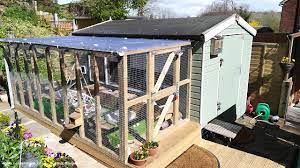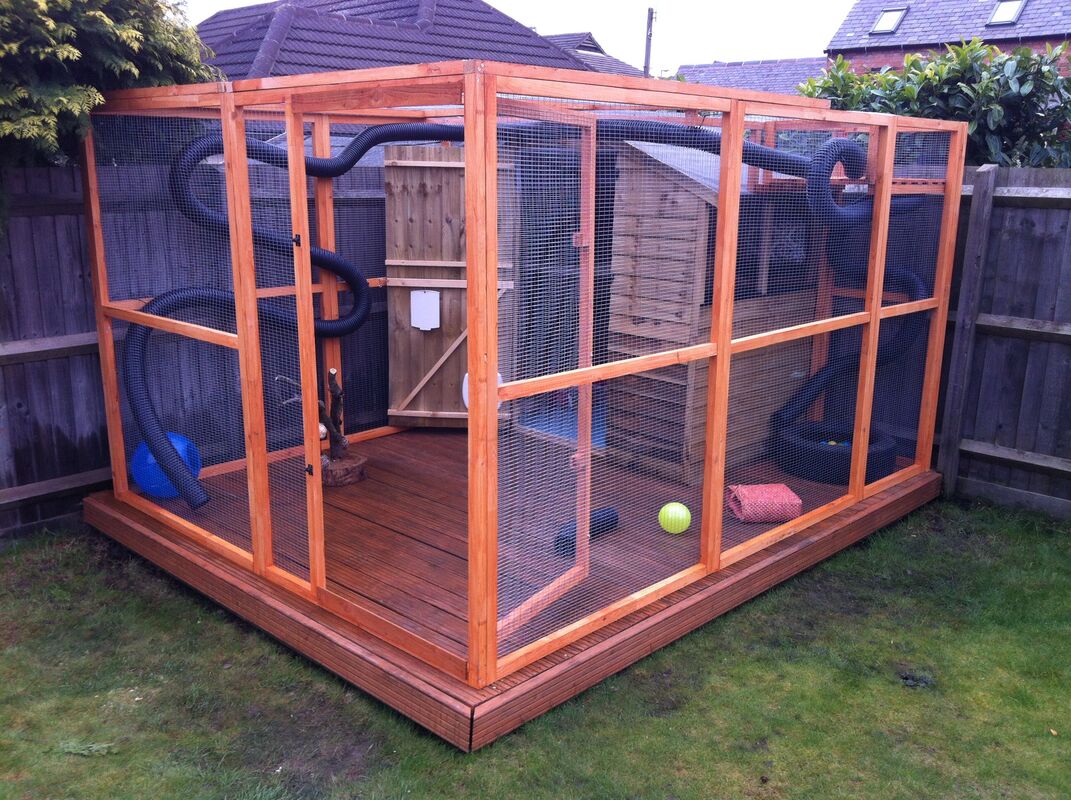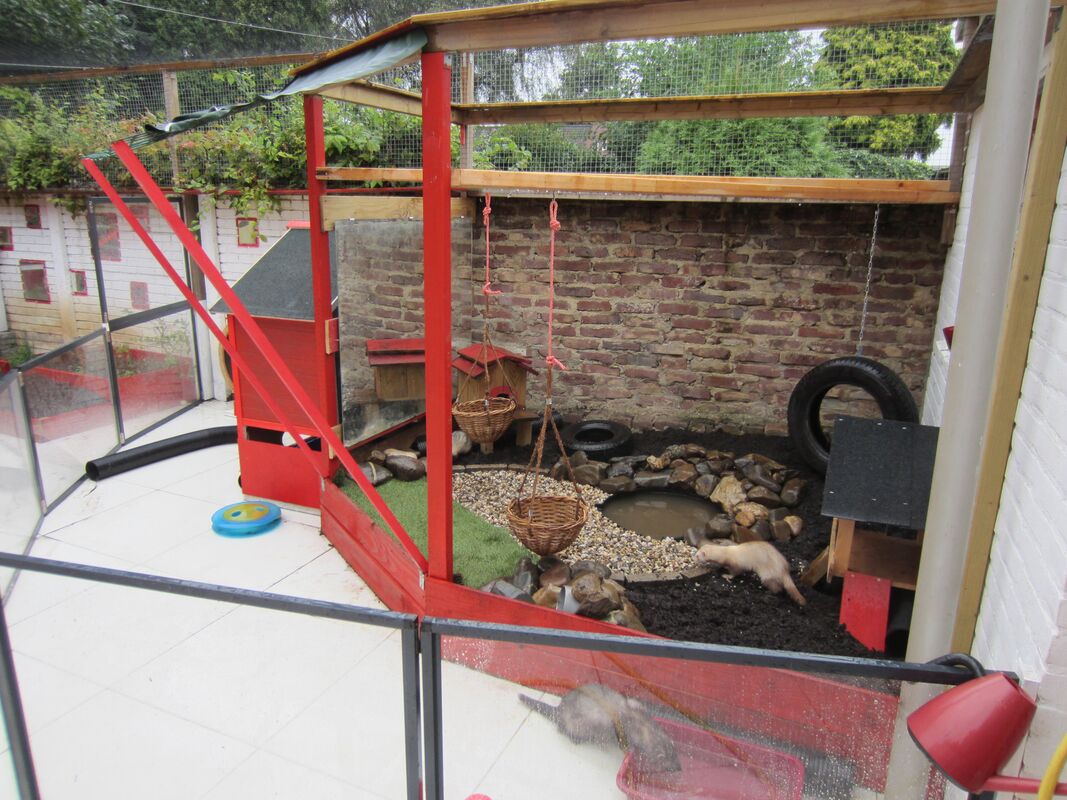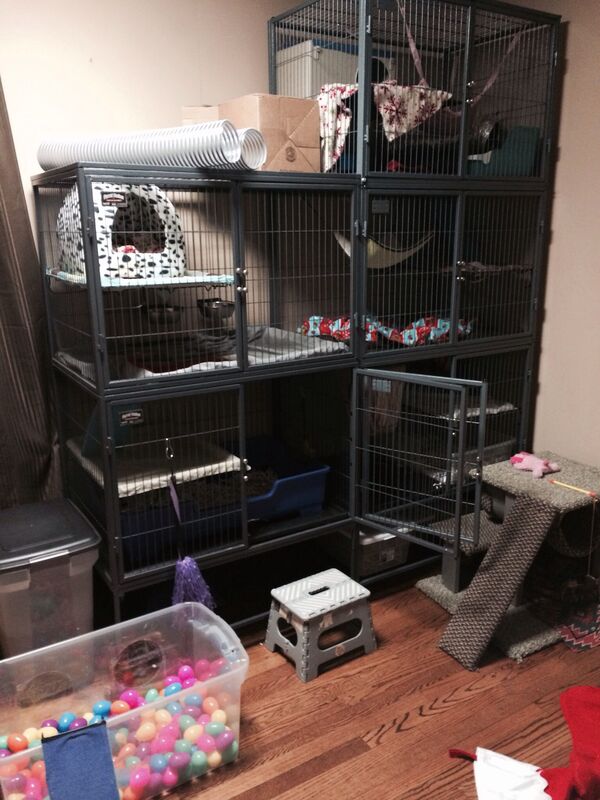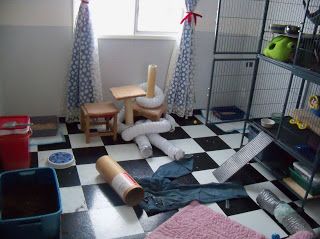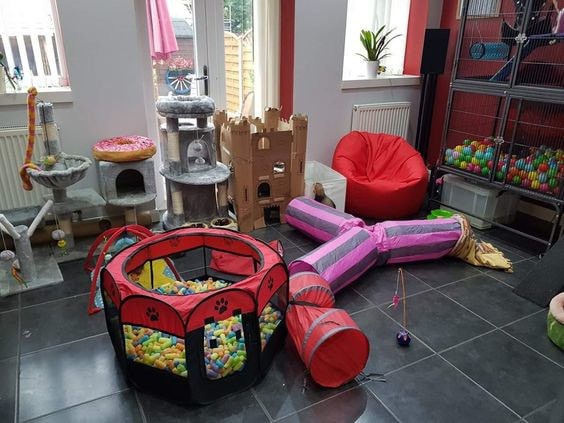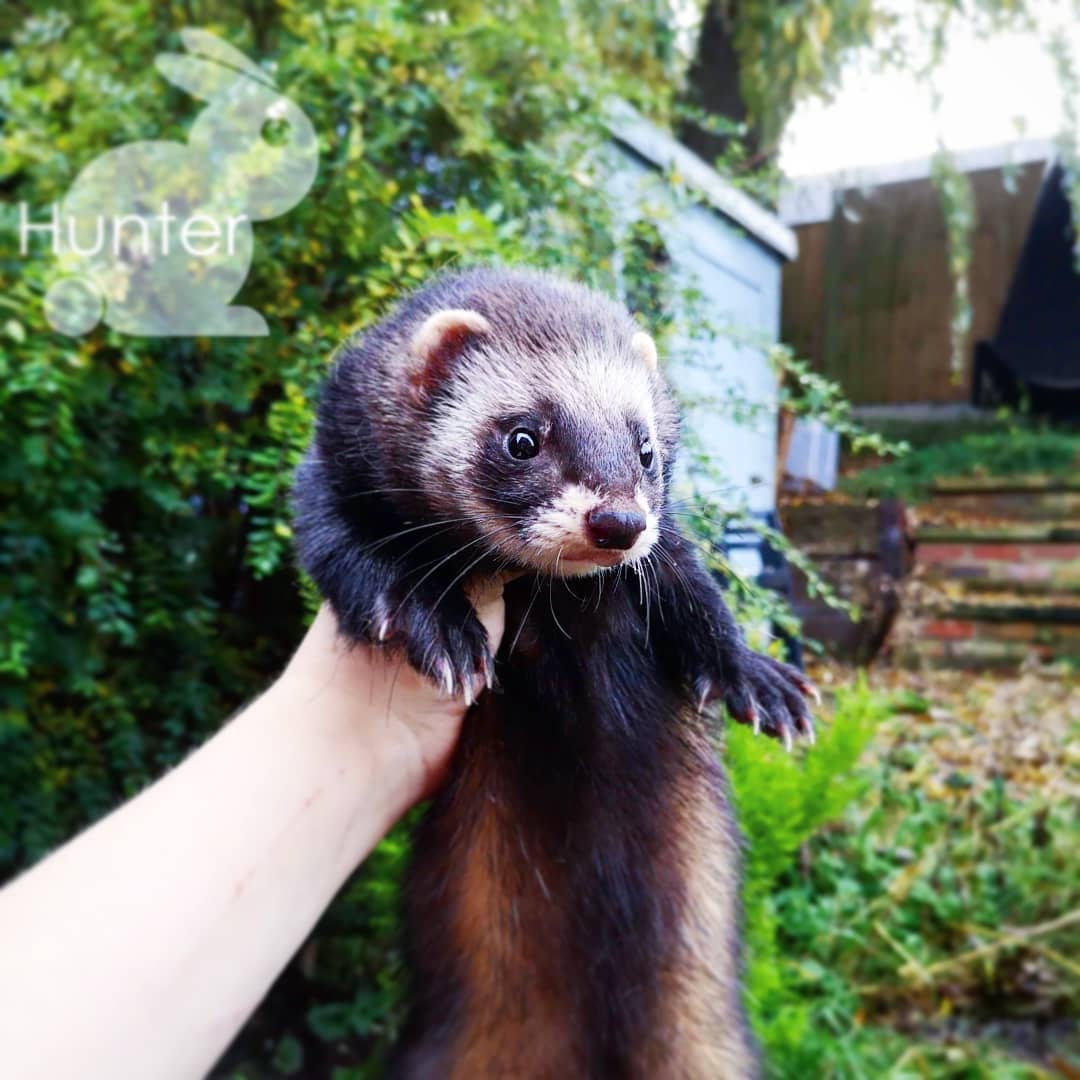General Information:
European polecats - previously referred to as a 'foul mart' due to their unpleasant scent - are considered to be the ancestor to the domestic ferret, but this is still up for debate to some. They're from the same family (mustelids) and also have a very similar appearance to some ferret coat varieties. Appearance may vary slightly depending on the subspecies.
One of the reasons individuals end up with a pet polecat is due to mistaken identity, as they're often confused with ferrets. There are slight anatomical differences between polecats and ferrets, but ,often, the easiest way to tell them apart is their behaviour.
Husbandry for the European polecat and hybrids is similar to their ferret cousin's, but they do often present with more problematic or feisty behaviour (not always, but frequently) as they're far more difficult to tame. Informally, they're referred to as a "ferret on steroids" as they're stronger, sometimes larger, and can be remarkably stubborn.
In our experience, their bite (which most aren't afraid to use) packs a powerful punch (baring in mind they technically have larger teeth than minks) and they're most certainly not a pet for the faint-hearted. Ferrets have thousands of years of domestication on their side, whereas polecats have a lot less. We consider our relationships with our hybrids/polecats a relationship of both love and respect. Everything must be on their terms and anything else, you will need to adapt to work around their individual behaviour. If you're considering an EU polecat as a pet, it is vital you work with them whilst they're younger.
European polecats have an average lifespan of 6-14 years in captivity. They're nocturnal, usually solitary and carnivorous.
Useful Links:
Care:
Housing/Enrichment:
We would house polecats/hybrids similarly to ferrets.
Just like ferrets, polecats/hybrids can be housed both indoors and outdoors, however, we personally prefer an outdoor environment.
Avoid housing around prey species such as rodents and rabbits. Ferrets are natural predators to most rodents; a polecat/hybrid's general scent can cause distress to prey animals.
Polecats are anatomically very similar to ferrets. They're known for their 'slinky' flexible bodies that make it very easy for them to escape through spaces you wouldn't initially expect.
Outdoors:
Personally, we much prefer ferrets housed outdoors in large enclosures where they can access both natural light and darkness.
You must ensure your outdoor enclosure is sturdy with a source of natural light. We would recommend a custom build insulated shed, perhaps even with metal-frames, an outbuilding. Access to natural lighting is beneficial for ferrets and polecats.
We advise that their outdoor area is safe from extreme weather conditions, this is particularly important in warmer weathers as they're extremely prone to heatstroke.
It's important to note that polecats are preyed upon by foxes, so your outdoor enclosures must be fox proof.
There is no official recommended sized housing for ferrets and polecats; it is vital that they have the ability to stand fully stretched on their hind limbs, have access to height and nest boxes, and have the ability to carry out natural behaviours. In our opinion, this makes hutches inappropriate for long-term housing.
European polecats - previously referred to as a 'foul mart' due to their unpleasant scent - are considered to be the ancestor to the domestic ferret, but this is still up for debate to some. They're from the same family (mustelids) and also have a very similar appearance to some ferret coat varieties. Appearance may vary slightly depending on the subspecies.
One of the reasons individuals end up with a pet polecat is due to mistaken identity, as they're often confused with ferrets. There are slight anatomical differences between polecats and ferrets, but ,often, the easiest way to tell them apart is their behaviour.
Husbandry for the European polecat and hybrids is similar to their ferret cousin's, but they do often present with more problematic or feisty behaviour (not always, but frequently) as they're far more difficult to tame. Informally, they're referred to as a "ferret on steroids" as they're stronger, sometimes larger, and can be remarkably stubborn.
In our experience, their bite (which most aren't afraid to use) packs a powerful punch (baring in mind they technically have larger teeth than minks) and they're most certainly not a pet for the faint-hearted. Ferrets have thousands of years of domestication on their side, whereas polecats have a lot less. We consider our relationships with our hybrids/polecats a relationship of both love and respect. Everything must be on their terms and anything else, you will need to adapt to work around their individual behaviour. If you're considering an EU polecat as a pet, it is vital you work with them whilst they're younger.
European polecats have an average lifespan of 6-14 years in captivity. They're nocturnal, usually solitary and carnivorous.
Useful Links:
Care:
Housing/Enrichment:
We would house polecats/hybrids similarly to ferrets.
Just like ferrets, polecats/hybrids can be housed both indoors and outdoors, however, we personally prefer an outdoor environment.
Avoid housing around prey species such as rodents and rabbits. Ferrets are natural predators to most rodents; a polecat/hybrid's general scent can cause distress to prey animals.
Polecats are anatomically very similar to ferrets. They're known for their 'slinky' flexible bodies that make it very easy for them to escape through spaces you wouldn't initially expect.
Outdoors:
Personally, we much prefer ferrets housed outdoors in large enclosures where they can access both natural light and darkness.
You must ensure your outdoor enclosure is sturdy with a source of natural light. We would recommend a custom build insulated shed, perhaps even with metal-frames, an outbuilding. Access to natural lighting is beneficial for ferrets and polecats.
We advise that their outdoor area is safe from extreme weather conditions, this is particularly important in warmer weathers as they're extremely prone to heatstroke.
It's important to note that polecats are preyed upon by foxes, so your outdoor enclosures must be fox proof.
There is no official recommended sized housing for ferrets and polecats; it is vital that they have the ability to stand fully stretched on their hind limbs, have access to height and nest boxes, and have the ability to carry out natural behaviours. In our opinion, this makes hutches inappropriate for long-term housing.
Indoors:
Polecats sill benefit from a play room; they need a secure an indoor space that your polecat/hybrids can roam. Most people adapt a room in their house which ensures that your pet cannot injure themselves. You must expect some damage to your home environment when keeping pets such as polecats - it comes with the territory!
Polecats, like ferrets, are inquisitive and playful animals. Consider providing toys such as hammocks, tubes, digging boxes, treat puzzles, cat towers, shallow water, and ball pits. We must provide toys that allow polecats to express natural behaviours.
Pay close attention to how many hours of light and darkness they recieve.
Litter training:
Polecats may be more stubborn to litter train than domestic ferrets, but it's still possible.
We would use the same tactics to train a polecat as we would with ferrets; patience and corner litter trays.
Polecats sill benefit from a play room; they need a secure an indoor space that your polecat/hybrids can roam. Most people adapt a room in their house which ensures that your pet cannot injure themselves. You must expect some damage to your home environment when keeping pets such as polecats - it comes with the territory!
Polecats, like ferrets, are inquisitive and playful animals. Consider providing toys such as hammocks, tubes, digging boxes, treat puzzles, cat towers, shallow water, and ball pits. We must provide toys that allow polecats to express natural behaviours.
Pay close attention to how many hours of light and darkness they recieve.
Litter training:
Polecats may be more stubborn to litter train than domestic ferrets, but it's still possible.
We would use the same tactics to train a polecat as we would with ferrets; patience and corner litter trays.
Socialising:
Although they're solitary by nature, some people keep polecats in mix-sexed neutered pairs. It is more common that a hob may live in a pair with a jill. You must neuter your polecats or hybrids regardless if they live alone. If you opt for castration or spaying as your method of neutering, we advise supporting this with a suprelorin implant to reduce the potential risk of adrenal disease. Alternatively, suprelorin implants can be used as a sole method of chemical neutering in males and females. The jill jab (progesterone) can be used with females, also.
As with most mustelids, polecats breed in seasons; jills enter oestrus under the influence of light.. If you're spaying a female polecat, we advise you do this out of season. The breeding season of the European polecat is between March and May in the Northern Hemisphere, but some individuals may be different. It's imperative you lookout out for the signs that your female is in season, such as a swollen vulva.
You can neuter your polecats at around 6 months old.
Neutering may improve behaviour and odour. Please bare in mind, you cannot neuter the polecat out of a polecat, as we say.
Useful Links:
Diet:
In the wild, European polecats mostly consume small rodents, but they also eat rabbits, amphibians, and reptiles.
Polecats have been documented to paralyse their prey, only to store it whilst still alive until they wish to consume it at a later date.
Replicating their diet in captivity can be difficult. Most people will recommend feeding them a diet identical to that of a ferret, particularly if you have a ferret/polecat hybrid.
The ferret/polecat is a strict/obligate carnivore which is easy to tell by their dentition, their short gastrointestinal tract, and lack of a caecum and ileocolic valve. They have a high metabolic rate so they need to eat little and often which is seen in many Mustelids. Many owners feed ad libitum. The average ferret is expected to eat approximately 5-7% of their body weight daily. It is recommended to have food available for them at all times. It is advised that ferrets have a high animal protein diet ranging from 35-40%, animal fat varying from 9-28%, carbohydrates <25%, and fibre <2.5%. Pelleted diets are recommended to be at the very least part of their daily diet as they’ve been documented to reduce the amount of dental calculus formed. You can find some premium kitten and cat pellets suitable for ferrets, as well as those marketed for ferrets. Feeding dog food is discouraged as dogs are able to process carbohydrates far more effectively than a ferret.
Raw meat diets have become increasingly popular, this has been referred to as BARF diet by the British Ferret Club. Clean sources of a whole prey/animal meat diet are now more widely available partially thanks to the reptile market. Many breeders and experienced keepers suggest a diet of 80% muscle meat, 10% secreting organs such as liver and kidney, and 10% bone which are loosely based off a whole prey model (some models have slightly different percentages). There are various available online diet plans which can help achieve this; from offering whole prey, specific body parts of a prey animal, or minced foods. Some raw food diets in particular may require additional supplementation. It is advised you feed more red meat than white (unless there is an underlying medical condition that states feeding otherwise), and avoiding pork. It is important that any meat provided is not of low-quality and containing too much indigestible protein such as fur, hooves, and too many bones, or too little muscle meat. Storing and handling of raw meat must also be done carefully, effectively, and hygienically to avoid contamination in both owner and ferret.
Ferrets may often become imprinted on a certain food type and be reluctant to eat any other foods offered. It is advised that a new owner is aware of what their new ferret is used to eating, and if changes need to be made then this should be done very gradually over a period of time.
Avoid feeding fruits, vegetables, and lactose.
Health:
Similarly to ferrets, the European polecat can also catch distemper. There is no licensed CDV vaccine for polecats, but off-licensed yearly vaccinations are the best way to protect your polecat.
What is CDV (canine distemper virus)?
Canine distemper is a fast-acting, often deadly, and a very contagious virus belonging to a class of viruses known as Morbillivirus; it's relative to measles.
CDV can affect the respiratory tract, gastrointestinal tract, and central nervous system of the infected individual. The disease can be transmitted via direct contact with an infected animal and can spread through the air through becoming airborne.
Symptoms include:
The prognosis for CDV is very poor, and most diagnoses are made post-mortem. Treatment is extensive and oftentimes expensive. Your polecat will be admitted as an inpatient, and quarantined away from other animals. Fluids, antiviral agents, antibiotics and immunosuppressants are ordinarily used to treat CDV.
In canines, more than 50% of dogs will die within 2-12 weeks after treatment. Early treatment will promote a higher chance of recovery, but a full recovery isn't guaranteed.
Prevention Methods:
In the UK, de-scenting ferrets and polecats (removing anal glands) is not allowed as it is considered an unnecessary mutation.
Please feel free to ask more questions.
Although they're solitary by nature, some people keep polecats in mix-sexed neutered pairs. It is more common that a hob may live in a pair with a jill. You must neuter your polecats or hybrids regardless if they live alone. If you opt for castration or spaying as your method of neutering, we advise supporting this with a suprelorin implant to reduce the potential risk of adrenal disease. Alternatively, suprelorin implants can be used as a sole method of chemical neutering in males and females. The jill jab (progesterone) can be used with females, also.
As with most mustelids, polecats breed in seasons; jills enter oestrus under the influence of light.. If you're spaying a female polecat, we advise you do this out of season. The breeding season of the European polecat is between March and May in the Northern Hemisphere, but some individuals may be different. It's imperative you lookout out for the signs that your female is in season, such as a swollen vulva.
You can neuter your polecats at around 6 months old.
Neutering may improve behaviour and odour. Please bare in mind, you cannot neuter the polecat out of a polecat, as we say.
Useful Links:
Diet:
In the wild, European polecats mostly consume small rodents, but they also eat rabbits, amphibians, and reptiles.
Polecats have been documented to paralyse their prey, only to store it whilst still alive until they wish to consume it at a later date.
Replicating their diet in captivity can be difficult. Most people will recommend feeding them a diet identical to that of a ferret, particularly if you have a ferret/polecat hybrid.
The ferret/polecat is a strict/obligate carnivore which is easy to tell by their dentition, their short gastrointestinal tract, and lack of a caecum and ileocolic valve. They have a high metabolic rate so they need to eat little and often which is seen in many Mustelids. Many owners feed ad libitum. The average ferret is expected to eat approximately 5-7% of their body weight daily. It is recommended to have food available for them at all times. It is advised that ferrets have a high animal protein diet ranging from 35-40%, animal fat varying from 9-28%, carbohydrates <25%, and fibre <2.5%. Pelleted diets are recommended to be at the very least part of their daily diet as they’ve been documented to reduce the amount of dental calculus formed. You can find some premium kitten and cat pellets suitable for ferrets, as well as those marketed for ferrets. Feeding dog food is discouraged as dogs are able to process carbohydrates far more effectively than a ferret.
Raw meat diets have become increasingly popular, this has been referred to as BARF diet by the British Ferret Club. Clean sources of a whole prey/animal meat diet are now more widely available partially thanks to the reptile market. Many breeders and experienced keepers suggest a diet of 80% muscle meat, 10% secreting organs such as liver and kidney, and 10% bone which are loosely based off a whole prey model (some models have slightly different percentages). There are various available online diet plans which can help achieve this; from offering whole prey, specific body parts of a prey animal, or minced foods. Some raw food diets in particular may require additional supplementation. It is advised you feed more red meat than white (unless there is an underlying medical condition that states feeding otherwise), and avoiding pork. It is important that any meat provided is not of low-quality and containing too much indigestible protein such as fur, hooves, and too many bones, or too little muscle meat. Storing and handling of raw meat must also be done carefully, effectively, and hygienically to avoid contamination in both owner and ferret.
Ferrets may often become imprinted on a certain food type and be reluctant to eat any other foods offered. It is advised that a new owner is aware of what their new ferret is used to eating, and if changes need to be made then this should be done very gradually over a period of time.
Avoid feeding fruits, vegetables, and lactose.
Health:
- Canine Distemper Virus:
Similarly to ferrets, the European polecat can also catch distemper. There is no licensed CDV vaccine for polecats, but off-licensed yearly vaccinations are the best way to protect your polecat.
What is CDV (canine distemper virus)?
Canine distemper is a fast-acting, often deadly, and a very contagious virus belonging to a class of viruses known as Morbillivirus; it's relative to measles.
CDV can affect the respiratory tract, gastrointestinal tract, and central nervous system of the infected individual. The disease can be transmitted via direct contact with an infected animal and can spread through the air through becoming airborne.
Symptoms include:
- Sneezing
- Fever
- Chin and groin rash
- Reduced appetite
- Coughing
- Thick mucus and/or pus discharge from eyes and nose
- Lack of coordination
- Diarrhoea
- Seizures
- Vomiting
- Hardening and swelling of the skin along nose and footpads
- Brown crusty eyes
The prognosis for CDV is very poor, and most diagnoses are made post-mortem. Treatment is extensive and oftentimes expensive. Your polecat will be admitted as an inpatient, and quarantined away from other animals. Fluids, antiviral agents, antibiotics and immunosuppressants are ordinarily used to treat CDV.
In canines, more than 50% of dogs will die within 2-12 weeks after treatment. Early treatment will promote a higher chance of recovery, but a full recovery isn't guaranteed.
- Dentition:
Prevention Methods:
- Daily brushing with a soft-bristled toothbrush and carnivore toothpaste - we appeciate this is quite difficult with some European polecat personalities.
- Off license water additives but be mindful that this often impacts water consumption levels
- Providing bones such as wings
- Topical cleansing gels
- Supplements to prevent plaque and tartar build up
- Annual veterinary oral examinations and tooth cleaning
In the UK, de-scenting ferrets and polecats (removing anal glands) is not allowed as it is considered an unnecessary mutation.
Please feel free to ask more questions.

